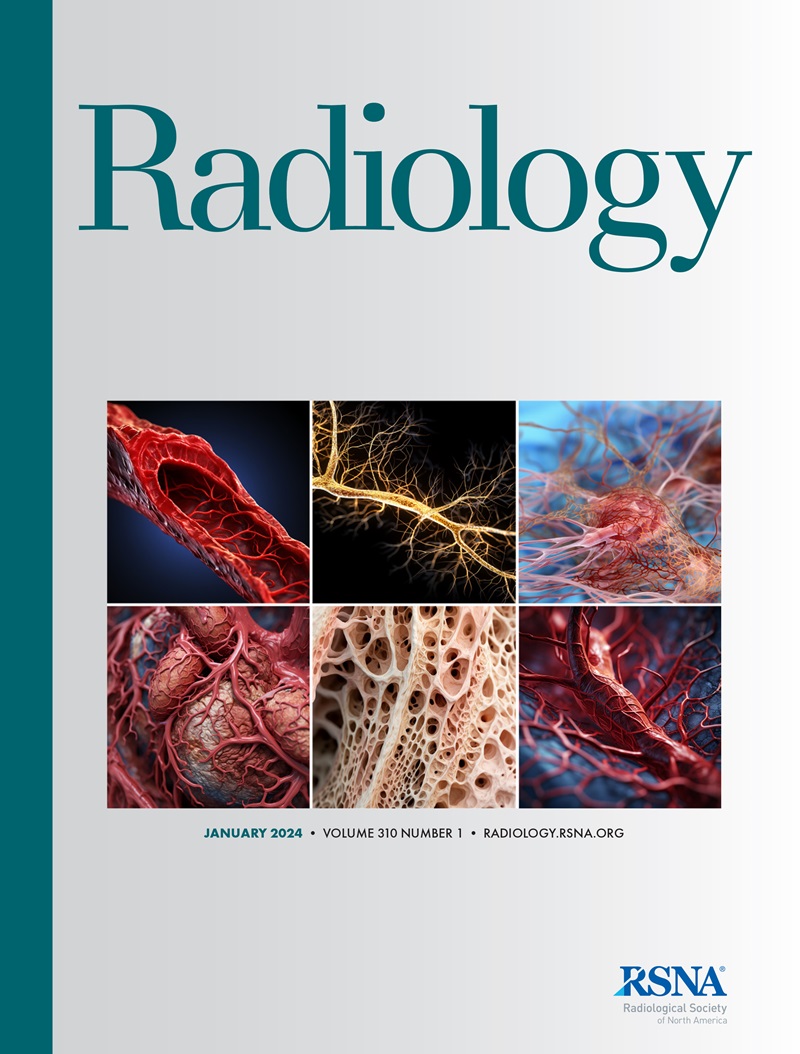Yanning Liu, Henk M De Feyter, Zachary A Corbin, Robert K Fulbright, Scott McIntyre, Terence W Nixon, Robin A de Graaf
求助PDF
{"title":"Parallel Detection of Multicontrast MRI and Deuterium Metabolic Imaging for Time-efficient Characterization of Neurologic Diseases.","authors":"Yanning Liu, Henk M De Feyter, Zachary A Corbin, Robert K Fulbright, Scott McIntyre, Terence W Nixon, Robin A de Graaf","doi":"10.1148/radiol.241597","DOIUrl":null,"url":null,"abstract":"<p><p>Background Deuterium metabolic imaging (DMI) is a novel, MRI-based method to map metabolism noninvasively in vivo and has potential to augment existing clinical MRI with unique metabolic information. However, adding DMI scans to a standard, clinical MRI protocol is challenging due to the relatively long scan time of DMI that can result in decreased patient compliance and increased scanning costs. Purpose To design and evaluate a parallel acquisition strategy, based on the large frequency difference between hydrogen proton (<sup>1</sup>H) and deuterium (<sup>2</sup>H) MRI signals, to obtain metabolic DMI data during a comprehensive, multicontrast (fluid-attenuated inversion recovery [FLAIR] and T1-, T2-, and susceptibility-weighted) MRI protocol without adding scanning time. Materials and Methods A parallel MRI DMI protocol based on four essential MRI types-FLAIR, and T1-, T2-, and susceptibility-weighted MRI-was interwoven with three-dimensional DMI by executing <sup>2</sup>H acquisition blocks during the contrast-generating delays intrinsic to MRI. Results Phantom and in vivo human brain data show that MRI scan quality, DMI sensitivity, and information content are preserved in the parallel MRI DMI acquisition method. DMI data acquired in parallel with MRI in a patient with an astrocytoma show unique metabolic image contrast that complements the multicontrast MRI examinations. Conclusion Parallel MRI scan acquisition technology was a practical solution to obtain both high-quality anatomic and metabolic scans without prolonging the scanning duration compared with an MRI-only protocol; the method had high flexibility to upgrade traditional MRI protocols with DMI and will be key for many clinical sites to gain access to DMI and drive its further development and validation by use in larger, diverse patient populations. © RSNA, 2025 <i>Supplemental material is available for this article</i>. See also the article by Bøgh et al in this issue. See also the editorial by Port in this issue.</p>","PeriodicalId":20896,"journal":{"name":"Radiology","volume":"315 1","pages":"e241597"},"PeriodicalIF":12.1000,"publicationDate":"2025-04-01","publicationTypes":"Journal Article","fieldsOfStudy":null,"isOpenAccess":false,"openAccessPdf":"","citationCount":"0","resultStr":null,"platform":"Semanticscholar","paperid":null,"PeriodicalName":"Radiology","FirstCategoryId":"3","ListUrlMain":"https://doi.org/10.1148/radiol.241597","RegionNum":1,"RegionCategory":"医学","ArticlePicture":[],"TitleCN":null,"AbstractTextCN":null,"PMCID":null,"EPubDate":"","PubModel":"","JCR":"Q1","JCRName":"RADIOLOGY, NUCLEAR MEDICINE & MEDICAL IMAGING","Score":null,"Total":0}
引用次数: 0
引用
批量引用
Abstract
Background Deuterium metabolic imaging (DMI) is a novel, MRI-based method to map metabolism noninvasively in vivo and has potential to augment existing clinical MRI with unique metabolic information. However, adding DMI scans to a standard, clinical MRI protocol is challenging due to the relatively long scan time of DMI that can result in decreased patient compliance and increased scanning costs. Purpose To design and evaluate a parallel acquisition strategy, based on the large frequency difference between hydrogen proton (1 H) and deuterium (2 H) MRI signals, to obtain metabolic DMI data during a comprehensive, multicontrast (fluid-attenuated inversion recovery [FLAIR] and T1-, T2-, and susceptibility-weighted) MRI protocol without adding scanning time. Materials and Methods A parallel MRI DMI protocol based on four essential MRI types-FLAIR, and T1-, T2-, and susceptibility-weighted MRI-was interwoven with three-dimensional DMI by executing 2 H acquisition blocks during the contrast-generating delays intrinsic to MRI. Results Phantom and in vivo human brain data show that MRI scan quality, DMI sensitivity, and information content are preserved in the parallel MRI DMI acquisition method. DMI data acquired in parallel with MRI in a patient with an astrocytoma show unique metabolic image contrast that complements the multicontrast MRI examinations. Conclusion Parallel MRI scan acquisition technology was a practical solution to obtain both high-quality anatomic and metabolic scans without prolonging the scanning duration compared with an MRI-only protocol; the method had high flexibility to upgrade traditional MRI protocols with DMI and will be key for many clinical sites to gain access to DMI and drive its further development and validation by use in larger, diverse patient populations. © RSNA, 2025 Supplemental material is available for this article . See also the article by Bøgh et al in this issue. See also the editorial by Port in this issue.
多层对比MRI和氘代谢成像并行检测用于神经系统疾病的高效表征。
氘代谢成像(DMI)是一种新颖的、基于MRI的无创体内代谢成像方法,有可能通过独特的代谢信息增强现有的临床MRI。然而,将DMI扫描添加到标准的临床MRI方案中是具有挑战性的,因为DMI扫描时间相对较长,可能导致患者依从性降低并增加扫描成本。目的设计和评估一种基于氢质子(1H)和氘(2H) MRI信号之间的大频率差异的并行采集策略,在不增加扫描时间的情况下,在全面、多对比(流体衰减反转恢复[FLAIR]和T1-、T2-和敏感性加权)MRI方案中获得代谢DMI数据。材料和方法基于四种基本MRI类型(flair, T1-, T2-和敏感性加权MRI)的并行MRI DMI协议通过在MRI固有的对比度产生延迟期间执行2H采集块与三维DMI交织。结果幻影和活体人脑数据显示,并行MRI DMI采集方法能保持MRI扫描质量、DMI灵敏度和信息含量。星形细胞瘤患者的DMI数据与MRI同时获得,显示出独特的代谢图像对比,补充了多重对比MRI检查。结论MRI并行扫描采集技术是一种实用的解决方案,可以获得高质量的解剖和代谢扫描,而不延长扫描时间。该方法具有高度的灵活性,可以将传统的MRI方案升级为DMI,并且将成为许多临床站点获得DMI的关键,并通过在更大、更多样化的患者群体中使用来推动其进一步发展和验证。©RSNA, 2025本文可获得补充材料。参见Bøgh等人在本期的文章。另见波特在本期的社论。
本文章由计算机程序翻译,如有差异,请以英文原文为准。

 求助内容:
求助内容: 应助结果提醒方式:
应助结果提醒方式:


